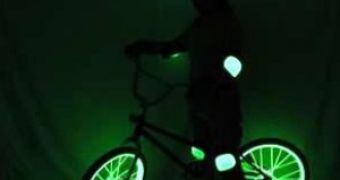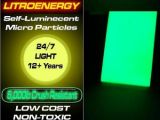Remember hydrogen's radioactive isotope resulted in nuclear reactors that we dump all over the place then accuse the nuclear power plants for radioactive poisoning? Well if you do, then you should also know that they finally found some good use for it lately.
Tritium is one of hydrogen's three isotopes and it's radioactive. It consists of a hydrogen nucleus that contains only one proton and two neutrons, has a half-life time averaging around 12 years and spontaneously decays by emitting beta radiation. It is usually used to initiate the chain nuclear fission reaction of Uranium and is a by product of the H-bomb explosion.
Most recently, scientists realized that they could put to good use the beta radiation emitted by the rare isotope, by creating illumination sources that do not need additional power input and can glow continuously for 12 years. A company called MPK designed a material called 'Litrosphere' that is commercialized at a price of about 35 cents a piece. MKP is specialized in designing glow-in-the-dark paints and other similar applications that involve illuminating sources that work without the input of external power.
The basic design of the material involves using the tritium radioactive gas as power source to energize phosphorus-coated microspheres that are beta-voltaic material, with the help of the beta radiation emitted by the hydrogen isotope. After the tritium gas passes its 12 year half-life time, the material stops glowing, as the isotope does not present beta-decay processes anymore.
The material is then used to coat a sheet of paper that can radiate light in different colors, is flexible and is not affected by severe temperature variations. Although the technology is not quite new or revolutionary the intensity of light and brightness it gives off cannot be used efficiently as a lighting source. However, it might replace part of the lighting sources that use relatively low amounts of energy but give off the same amount of light as the new material.
Similar use of the power emitted during beta-decay could possibly produce batteries that give off continuous electric current outputs to be used in the automobile industry. The company that developed it now has its eyes on the 1 million dollar prize offered by the U.S. Department of Defense for the development of the first battery backpack.

 14 DAY TRIAL //
14 DAY TRIAL // 
